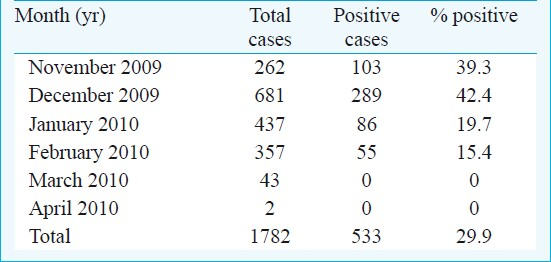Translate this page into:
Cases of pandemic influenza A (H1N1) 2009 in western Rajasthan, India
+For correspondence: vinodjoshi@dmrcjodhpur.org
This is an open-access article distributed under the terms of the Creative Commons Attribution-Noncommercial-Share Alike 3.0 Unported, which permits unrestricted use, distribution, and reproduction in any medium, provided the original work is properly cited.
This article was originally published by Medknow Publications & Media Pvt Ltd and was migrated to Scientific Scholar after the change of Publisher.
Sir,
Pandemic influenza A (H1N1) 2009 has appeared as a major disease outbreak recently1. North-western Rajasthan, India, witnessed severe epidemic of this influenza type from November, 2009 till January, 2010. Presence and distribution of test positive cases of pandemic (H1N1) 2009 was studied to report the occurrence of diseases in this region and to generate knowledge on the epidemiological transition of disease in the affected areas.
As one of the authorized laboratories of Indian Council of Medical Research, in the State of Rajasthan, we provided molecular diagnosis of throat swabs collected from the patients suffering from influenza-like illness (ILI)2 by the group of hospitals associated with Dr S.N. Medical College, Jodhpur from November, 2009 till April, 2010. This hospital based study reports the test positive results of pandemic (H1N1) 2009 cases based on the molecular diagnosis of 1782 throat swabs from six districts of north-western Rajasthan, India.
The throat swabs of suspected cases of ILI were collected by the treating physicians of associated group of hospitals attached with the medical college. The patients without sudden fever (<38°C) and sore or cough throat, were excluded. The tip of the swab was put in a vial containing 2-3 ml of viral transportation medium (VTM) and transported in cold containers to our laboratory following WHO protocol2. The samples were kept at 4°C in a Bio Safety Level (BSL-2) laboratory designed for the purpose of molecular diagnosis of pandemic (H1N1) 2009.
The throat swabs in VTM were processed in a Bio Safety Cabinet (BSC II) manufactured by M/s ESCO, Singapore. As per the laboratory criteria for diagnosis of influenza specimens suggested by WHO, the RT-PCR protocol was adopted2. Processing of samples was done according to the CDC standard protocol3. High speed ultracentrifuge (Optima Max-XP, Beckman Coulter, USA) and refrigerated centrifuges (Universal 320 R, Hettich, Germany) were used. Samples divided into aliquots for re-testing and long storage purpose were stored in ultra low deep freezer (New Brunswick Scientific, UK). Use of appropriate biosafety measures and personal protection equipment (PPE) were as per CDC's and WHO laboratory biosafety guidelines45. RNA extraction kit (Qiagen, USA) and primers (ABI, USA) were also according to the CDC protocol3. The RT PCR equipment model 7500 (ABI, USA) was used. The clinical details of the patients were collected from the records.
Of the total 1782 throat swab samples of suspected cases with ILI diagnosed for pandemic (H1N1) 2009, 533 (29.9%) were tested positive. Maximum cases (298; 42.4%) were observed during December 2009. The epidemic of pandemic (H1N1) 2009 persisted during November 2009 (39.3%) till February 2010 (15.4%). No cases were observed during March and April 2010 (Table).

In rural (125; 45.4%) as well as urban areas (164; 40.6%), maximum cases of pandemic (H1N1) 2009 were observed during December 2009 (289; 42.4%) and least (22; 18.4% in rural areas & 33; 13.8% in urban areas) during February 2010. Pooled data suggested that 206 (32.4%) of 634 samples examined from the patients reporting from the rural areas were positive, whereas 327 (28.4%) of 1158 samples tested from urban areas, were found positive.
Age-wise distribution of pandemic (H1N1) 2009 test positive cases was made among men as well as women in urban and rural areas. In urban areas, maximum positive cases were observed in the age group of 21-30 yr (91 cases; 29.54%) of which 47 were male and 44 female. Similarly, in rural areas, maximum incidence of pandemic (H1N1) 2009 was observed in the age group of 21-30 yr (60 cases, 30%) of which 22 were male and 38 female.
Pandemic (H1N1) 2009 has appeared as a major outbreak recently, with India as one of the severely affected countries1. Many reports on its occurrence in Mexico6, Japan7 and England8 have been published. However, very limited data on the occurrence of pandemic (H1N1) 2009 from different part of India have been published9. This perhaps is the first report on the occurrence of this disease from Rajasthan, India. The first case of pandemic (H1N1) 2009 from India was reported from Hyderabad in the travellers from USA1. The present data show commencement of disease in western Rajasthan since November 2009.
Acknowledgment
Authors acknowledge the Director-General, Indian Council of Medical Research, New Delhi for financial support, and Dr Bela Shah, Director-In-Charge, DMRC (ICMR), for guidance. Authors thank Drs A.C. Mishra and J. Mullick, National Institute of Virology (ICMR), Pune, for providing the training and reagents/kits.
References
- Ministry of Health and Family Welfare, Government of India. Influenza A (H1N1). Press Release of May 16, 2009. Available from: http:/mohfw.nic.in/swineachive.htm
- [Google Scholar]
- WHO. 2008. A practical guide to harmonizing virological and epidemiological influenza surveillance. Available from: www.wpro.who.int/internet/resources.ashx/CSR/Publications/GuideToHarmonizingInfluenzaSurveillance-revised2302.pdf
- [Google Scholar]
- WHO. 2009. CDC Protocol of real time RT-PCR for influenza A (H1N1). Available from: http://www.who.int/csr.resources/publications/swinflu/ CDCRealtimeRTPCRprotocolSwineH1Ass-2009 20090428.pdf
- [Google Scholar]
- World Health Organization. In: Laboratory biosafety manual (3rd ed). Geneva: WHO; 2004.
- [Google Scholar]
- Biosafety in microbiological and biological laboratories (5th ed). Washington DC: CDC and NIH. U.S. Department of Health and Human Services; 2007.
- Outbreak of swine-origin influenza A (H1N1) virus infection-Mexico, March-April 2009. MMWR Morb Mortal Wkly Rep. 2009;58:467-70.
- [Google Scholar]
- Transmission potential of the new influenza A (H1N1) virus and its age-specificity in Japan. Euro Surveill. 2009;14(22)
- [Google Scholar]
- An outbreak of influenza A (H1N1)v in a boarding school in south east England, May-June 2009. Euro Surveill. 2009;14(27)
- [Google Scholar]
- Pandemic influenza A(H1N1) 2009 outbreak in a residential school at Panchgani, Maharashtra, India. Indian J Med Res. 2010;132:67-71.
- [Google Scholar]





